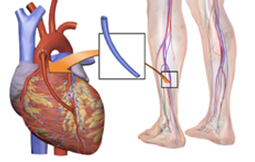
Heart bypass surgery, or coronary artery bypass graft (CABG) surgery, is used to replace damaged arteries to improve blood flow around the blocked or narrow section in the arteries by supplying blood and oxygen to the heart. A surgeon uses blood vessels taken from another area of your body to bypass the damaged arteries. These arteries supply your heart with oxygenated blood.
In a bypass surgery or coronary artery bypass graft (CABG) surgery, the surgeon uses blood vessels taken from another area of your body to bypass the damaged arteries. Heart bypass surgery, or coronary artery bypass graft (CABG) surgery, is used to replace damaged arteries to improve blood flow around the blocked or narrow section in the arteries by supplying blood and oxygen to the heart. The arteries supply your heart with oxygenated blood. If these arteries are blocked or blood flow is restricted, the heart enables to work properly can lead to heart failure. If you looking for a bypass and want to know the surgery cost in India or have any other questions regarding the surgery, please feel free to contact our doctors and they will provide you with all the necessary details about medical tourism for heart disease in India.
It is the left and right coronary arteries that supply this blood and oxygen without any interruptions. But in cases sometimes a condition called atherosclerosis can cause the arteries to become narrow due to fatty acid build up around them. This is known as coronary heart disease. Coronary bypass surgery is performed usually in emergency situations, such as a heart attack if you’re not responding to other treatments. Same as other parts of our body, the heart requires a regular supply of blood and oxygen.
A severe case of atherosclerosis occurs with the supply of oxygen-rich blood to the heart, causing chest pain and an ailment called angina. A cardiologist will recommend an open heart bypass surgery in the following cases:
Before the surgery the surgeon will recommend some necessary lifestyle changes, medications and diet changes required ahead in the surgery. The following pre-surgical tests will be recommended to determine patient’s overall health and wellbeing and also to check the status of artery blockages:
It takes around three to six hours for bypass surgery to finish, depending on the heart blockages and their severity. An experienced cardiac surgeon along with his trusted team will perform the operation under general anesthesia.
Once the heart surgery is done the patient is moved into the Intensive Care Unit (ICU) to monitor his/her health and heart. The patient might have to spend a day or two in the intensive care unit. There’s a breathing tube that will remain in the throat until the patient is awake and able to breathe on his/her own. Based on the patient’s response to the surgery, the patient will then be moved to a normal room where you might have to stay for about a week. It can take around three to four weeks to resume normal routines after the surgery. The patient will be recommended to attend a cardiac rehabilitation program for faster recovery through exercise and education. The patient should constantly have follow-ups as directed by the surgeon since that will monitor his/her progress and determine any unexpected relapse in the treatment.
Even with coronary bypass surgery, your doctor will recommend some lifestyle changes after surgery. Medications are prescribed routinely after coronary bypass surgery to lower your blood cholesterol, reduce the risk of developing a blood clot and help your heart function as well as possible. After a bypass surgery, most people feel better and might remain symptom-free for as long as 10 to 15 years but as this is open heart surgery, the risks and complications are comparatively higher. Though it is assured that the doctors and surgeons will do their best to deliver a successful operation, you must be aware of the risks before you make your decision. The risks and complications largely depend on the status of your health before your surgery and the chances of risks are maybe higher when the surgery is an emergency procedure. Some of the possible risks include:
Copyright © 2025 IMA | All Rights Reserved.